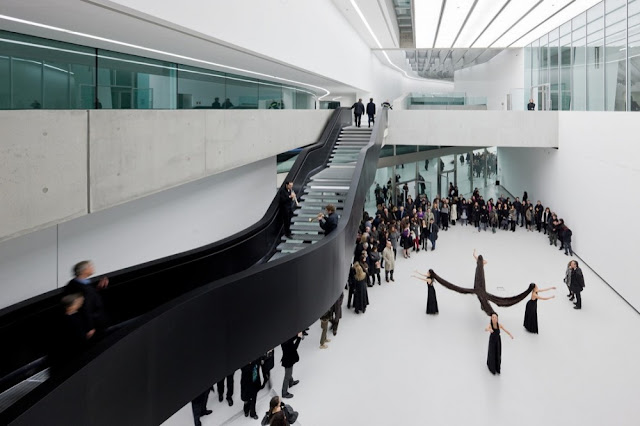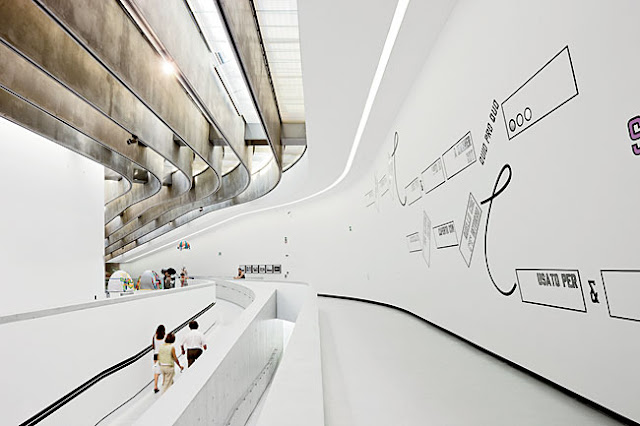Rome, Italy
Zaha Hadid Architects
Post By:Kitticoon Poopong
 |
| Photo © Courtesy of Iwan Baan |
MAXXI: Zaha Hadid Taps into Rome’s past while creating its most contemporary building in decades.
In Rome, history flows through every urban artery, providing a strong pulse to obscure outposts and tourist destinations alike. For architects, the
Eternal City presents history as inspiration, obstacle, and challenge. With the National Museum of XXI Century Arts (MAXXI), which opened in May in the Flaminio district just outside the city’s historic core, Zaha Hadid treats it as a river — a fluid construct comprising a series of streams — converging, overlapping, then changing course. In the process, she taps into powerful flows of the Roman past and delivers her most convincing building to date — a sensual piece of construction that works both urbanistically and as a place to view art.
 |
| Photo © Courtesy of Iwan Baan |
 |
| Photo © Courtesy of Iwan Baan |
More than 10 years in the making, MAXXI offers visitors a trip to Hadid’s past, as well as Rome’s. When she entered the competition for the project in 1999 and made it to the short list of 15 architects (which included Steven Holl,
Toyo Ito,
Rem Koolhaas,
Jean Nouvel, and
Kazuyo Sejima), she had built very little and employed only about 30 people. Today, her staff numbers more than 350 and she is building major projects around the world. The year 1999 turned out to be a pivotal moment in her career, starting with a set of unsuccessful competitions and ending with her busy designing two projects in Germany — the
Phaeno Science Center and the
BMW Central Building — and a transit terminus in France, in addition to MAXXI.
 |
| Photo © Courtesy of Iwan Baan |
In each of these projects, Hadid and her partner, Patrik Schumacher, approached the building as a “quasi-urban field, a ‘world’ to dive into rather than a signature object,” explains Hadid. With MAXXI, the architects confronted a site covered by a set of military barracks, some of which they could remove and some they needed to keep. Their design incorporates a military building on Via Guido Reni to the south and carves out a public plaza running the length of the site to Via
Masaccio on the north. In addition to opening a pedestrian connection through the city block, the scheme acknowledges the angled street grid beyond Via Masaccio — twisting the museum building to align with a nearby streetcar line. Or, as the architects explain in their tortured project text, “An inferred mass is subverted by vectors of circulation.”
 |
| Photo © Courtesy of Iwan Baan |
 |
| Photo © Courtesy of Iwan Baan |
Matching the three-story height of its neighbors and wiggling between and around them, MAXXI cleverly embeds itself in the fabric of this emerging part of town. Along with Renzo Piano’s Parco della Musica Auditorium (2002) and Pier Luigi Nervi’s Sports Palace (1960) just a few blocks away, MAXXI is turning what had been an industrial and military area into a new arts district. As you approach the museum along Via Guido Reni, you notice only a pair of modest bookends on either side of a restored barracks. So when you walk into the entry plaza, the size and twisting form of MAXXI take you by surprise. But the way it connects to the different city grids on the north and the south and its sinuous allusion to the nearby Tiber river make it feel very much a part of this place.
 |
| Photo © Courtesy of Iwan Baan |
 |
| Photo © Courtesy of Iwan Baan |
 |
| Photo © Courtesy of Iwan Baan |
When the project began, it was unclear what kind of museum would occupy the building. There was talk of focusing on Arte Povera — a movement that emerged in Italy in the 1960s. Eventually, the national government set up Fondazione MAXXI, made up of two parts — one devoted to art and the other to architecture — and both dedicated to contemporary work. To deal with the uncertainty of the art to be displayed, Hadid approached the museum as a “frame or clearing for the unknown and untested.” As built, the museum leads visitors along winding paths accented by lengths of concrete fins suspended from glass-and-steel roofs; some of the fins hold lights and other utilities, while others have tracks for securing temporary partitions. The galleries work best for big works of art and challenge curators to think creatively in displaying smaller pieces.
 |
| Photo © Courtesy of Iwan Baan |
 |
| Photo © Courtesy of Iwan Baan |
Due to its complex geometry, the building “is not easily understandable at first,” says project architect Gianluca Racana. Just as one needs to explore an Italian city on foot, visitors must wander around MAXXI — ascending forking stairs and following tiered galleries accessed by long ramps. On both the inside and the outside, the museum works as a series of connected ribbons, a composition that conjures the spirit of Baroque architecture with its play of convex and concave forms. And like buildings designed by Borromini and Bernini, MAXXI manipulates daylight in an almost mystical way — bringing it in from above, through glass roofs shielded by metal grilles, adjustable louvers, and concrete fins. Fluorescent tubes in the stairs and light boxes on the underside of circulation routes give these elements the appearance of floating and add to the museum’s liquid approach to space.
 |
| Photo © Courtesy of Iwan Baan |
 |
| Photo © Courtesy of Iwan Baan |
Reinforcing this fluid character, the architects designed the building as a poured-concrete structure, exposed on the inside and out. To handle the complex geometry, they used self-compacting concrete. And to ensure an continuous supply of concrete, they built a factory on-site. Four expansion joints split the building for seismic reasons. But uniform finishes give visitors the impression of moving through uninterrupted space. One of the few false moments, however, happens on the second floor where a north—south gallery meets a tiered set of display spaces; instead of a seamless convergence, a glass wall and doors separate the two flows.
 |
| Photo © Courtesy of Iwan Baan |
“
I think this is the best building Zaha will ever do,” states Pippo Ciorra, senior curator of architecture at MAXXI. “Because the project took so long and she had a small firm when it started, she was able to fully develop the design,” he explains. Some people have criticized the building as overwhelming the art inside it. Pio Baldi, president of Fondazione MAXXI, disagrees, saying the continuous galleries allow visitors to see art from different perspectives. The museum has certainly shaken up Rome’s often staid world of art and architecture, provided a jolt of creative energy to the Flaminio district, and given visitors a thrilling place to think about the future while still connected to the city’s rich past.
 |
| Photo © Courtesy of Iwan Baan--A system of steel stairs and ramps serves as a counterpoint to the building’s concrete structure. Built off-site and delivered in sections no larger than 7 feet, the stairs were painted black using the same technology manufacturers use for cars. |
 |
| Photo © Courtesy of Iwan Baan |
 |
| Photo © Courtesy of Iwan Baan--A gallery on the third floor cantilevers 45 feet beyond the building’s main structure. A tilted glass wall offers views over the public plaza. |
 |
| Photo © Courtesy of Iwan Baan--A forking bridge above the entry was supposed to connect to a pair of outbuildings on the other side of the plaza, but the client decided to renovate an existing building there instead for use as a café, bookstore, and offices. |
 |
| Photo © Courtesy of Iwan Baan--The 228,000-square-foot building includes 108,000 square feet of galleries, some of which are accessed by a long winding ramp. Some of the concrete fins suspended from the steel-and-glass roofs provide power for lights, while others hold tracks to support temporary walls for exhibitions. |
 |
| Photo © Courtesy of Iwan Baan--A system of metal grilles, blinds, and adjustable louvers controls sunlight streaming into galleries. |
 |
| Photo © Courtesy of Iwan Baan--Instead of a traditional set of galleries as rooms, the architects designed a series of continuous spaces where walls both shape the setting and serve as surfaces on which to mount or project art. |
 |
| situation plan--drawing Courtesy of Zaha Hadid Architects |
 |
| ground floor plan--drawing Courtesy of Zaha Hadid Architects |
 |
| first floor plan--drawing Courtesy of Zaha Hadid Architects |
 |
| second floor plan--drawing Courtesy of Zaha Hadid Architects |
 |
| roof plan--drawing Courtesy of Zaha Hadid Architects |
 |
| section 01--drawing Courtesy of Zaha Hadid Architects |
 |
| section 02--drawing Courtesy of Zaha Hadid Architects |
 |
| section 03--drawing Courtesy of Zaha Hadid Architects |
 |
| detail 01--drawing Courtesy of Zaha Hadid Architects |
 |
| detail 02--drawing Courtesy of Zaha Hadid Architects |
The People Architect
Zaha Hadid Architects
10, Bowling Green Lane
EC1R 0BQ London, UK
Ph: +44 (0)207 253 5147
fax: +44 (0)207 251 8322
Architects:
Zaha Hadid and Patrik Schumacher (Registered architects)
Project Architect:
Gianluca Racana (Registered architect)
Design Team:
Anja Simons, Paolo Matteuzzi, Fabio Ceci,Mario Mattia, Maurizio Meossi, Paolo Zilli, Luca Peralta, Maria Velceva, Matteo Grimaldi, Ana M.Cajiao, Barbara Pfenningstorff, Dillon Lin, Kenneth Bostock, Raza Zahid, Lars Teichmann, Adriano De Gioannis, Amin Taha, Caroline Voet, Gianluca Ruggeri, Luca Segarelli (registered architects)
Engineer(s):
Structural Engineering:
Anthony Hunt Associates, OK Design Group, Studio SPC S.r.l.
Mechanical Engineering:
Max Fordham and Partners, OK Design Group
Consultant(s)
Lighting:
Equation Lighting
Acoustical:
Paul Gilleron Acoustic
General contractors:
Italiana Costruzioni s.p.a.
SAC
Photographer(s)
Iwan Baan
+31 (0)6 5463 0468
Werner Huthmacher
+49 (30) 614 039 67
Richard Bryant
+44 (0)20 8546 4352
Renderer(s)
Courtesy of Zaha Hadid Architects |
| The ProductsExterior cladding Concrete:
GRC System Building s.r.l.
Formwork:
PERI S.p.A.
Windows METALSIGMA Tunesi SpA
SAN.CO.
Glazing
Skylights:
LORENZON
Metal stairs:
COMIC 2000 S.p.A.
Pontina Impianti SAS
Floor
KERAKOLL
Conveyance
Elevators/Escalators:
KONE Ascensori S.p.A.
Accessibility provision (lifts, ramping, etc.):
KONE Ascensori S.p.A. |
































